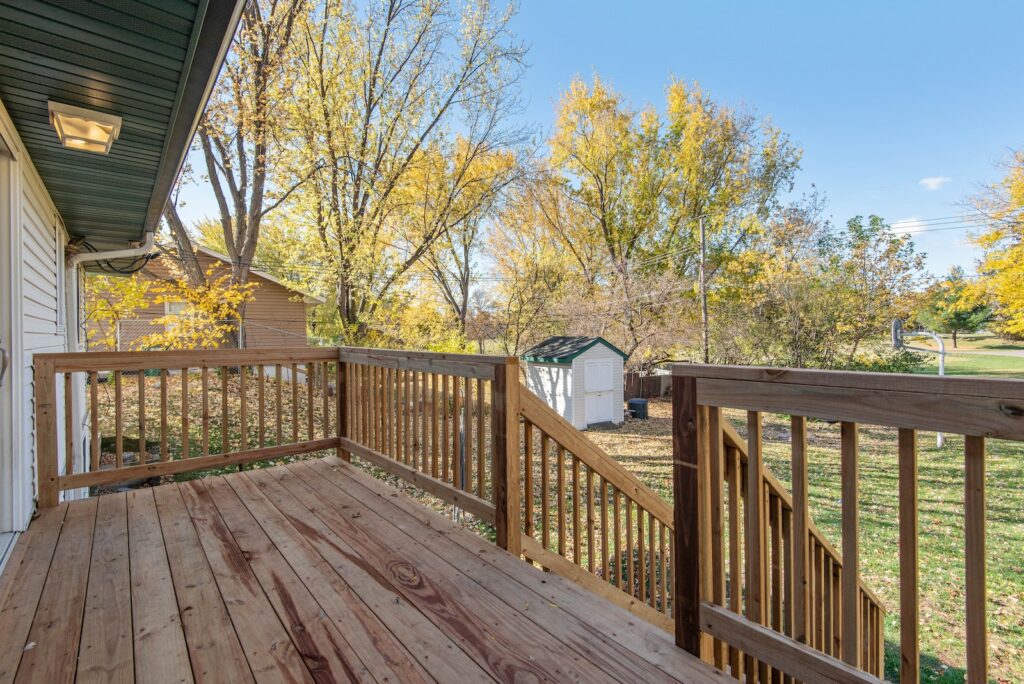If you’re wondering can you repair deck posts, the answer is yes! With the right tools and knowledge, you can fix your deck and make it look brand new again. Read on for tips and tricks on how to repair your deck posts.
Can you repair deck posts?
Contents
- 1 Can you repair deck posts?
- 2 Diagnosing the Problem
- 3 Can a damaged deck post be reinforced?
- 4 How much does it cost to repair a deck post?
- 5 How long does it take to repair a deck post?
- 6 Repairing Deck Posts
- 7 What tools do I need to repair a deck post?
- 8 Can a deck post be repaired without removing deck boards?
- 9 What type of lumber should be used for deck post repairs?
- 10 What are some alternative solutions to repairing a damaged deck post?
- 11 What are some common mistakes to avoid when repairing deck posts?
- 12 Can I repair a deck post myself or should I hire a professional?
- 13 FAQs
- 14 Final thoughts on can you repair deck posts
Decks are a popular addition to many homes, providing a space to enjoy the outdoors and entertain guests. However, over time, the posts that support the deck can become damaged and weaken, compromising the safety and stability of the entire structure.
If you’re wondering if you can repair deck posts, the answer is yes! In this article, we’ll cover everything you need to know about fixing your deck posts, from diagnosing the problem to selecting the right tools and materials.
Diagnosing the Problem
Before you can start repairing your deck posts, you need to identify the problem. Here are some common issues you may encounter:
Rotting or Decay
Wooden deck posts are susceptible to rotting and decay, especially if they are in contact with the ground. Signs of rotting include soft spots, discoloration, and a musty odor.
Cracks or Splits
Over time, the wood in deck posts can dry out and crack or split. This can weaken the structure and make it unsafe to use.
Warping or Twisting
Wooden deck posts can warp or twist due to exposure to moisture and sunlight. This can cause the posts to become uneven or unstable.
Can a damaged deck post be reinforced?
If you have a damaged deck post, you may be wondering if it can be reinforced. The answer is yes, in many cases. Reinforcing a damaged deck post can help to provide additional support and stability, which can help to extend the life of your deck. There are a few different ways that a deck post can be reinforced, including:
- Adding additional lumber: One way to reinforce a deck post is to add additional lumber to the existing post. This can be done by attaching additional boards to the sides of the post, or by adding a support beam adjacent to the post.
- Installing metal brackets: Another option for reinforcing a deck post is to install metal brackets. These brackets can be attached to the post and the adjacent joist or beam, helping to provide additional support and stability.
- Using epoxy: If the damage to the deck post is minor, it may be possible to use epoxy to reinforce the damaged area. Epoxy can be applied to the damaged area to help fill in any cracks or gaps and provide additional support.
By reinforcing a damaged deck post, you can help to ensure that your deck remains stable and safe for years to come.
How much does it cost to repair a deck post?
The cost of repairing a deck post can vary depending on the extent of the damage and the type of repair that is needed. Some factors that can affect the cost of deck post repair include:
- Materials: The cost of materials can vary depending on the type of lumber that is used and the type of repair that is needed.
- Labor: If you hire a professional to repair your deck post, the cost of labor will also need to be factored in.
- Accessibility: If the damaged post is difficult to access, such as if it’s located in a hard-to-reach area, the cost of repair may be higher.
- Additional repairs: If the damage to the deck post has caused damage to other parts of the deck, such as the railing or joists, additional repairs may be needed, which can increase the cost.
On average, the cost of repairing a deck post can range from $100 to $500, depending on the factors listed above. It’s important to get a quote from a professional before beginning any repairs to ensure that you have an accurate idea of the cost.
How long does it take to repair a deck post?
The length of time it takes to repair a deck post can vary depending on the extent of the damage and the type of repair that is needed. Some factors that can affect the length of time needed for deck post repair include:
- Accessibility: If the damaged post is difficult to access, it may take longer to repair.
- Type of repair: Some repairs, such as reinforcing a deck post or patching a cosmetic issue, may be quicker than replacing the entire post.
- Weather: If the weather is bad, such as if it’s raining or snowing, it may be difficult to complete the repair, which can delay the process.
On average, the length of time it takes to repair a deck post can range from a few hours to a full day. If additional repairs are needed, such as if the damage has spread to other parts of the deck, it may take longer to complete the repair. It’s important to plan ahead and schedule the repair for a time when you can dedicate the necessary time and attention to the project.
Repairing Deck Posts
Once you’ve identified the problem with your deck posts, it’s time to start the repair process. Here are some tips and tricks to help you fix your deck:
Replace the Post
If the damage to your deck post is severe, you may need to replace the entire post. This involves removing the damaged post and installing a new one in its place. Here’s how:
- Use a reciprocating saw to cut through the damaged post, making sure to avoid cutting into the deck or any nearby structures.
- Remove the remaining portions of the post using a pry bar or hammer.
- Measure the length of the new post and cut it to size using a saw.
- Insert the new post into the hole, making sure it is level and plumb.
- Secure the post in place with screws or bolts.
Reinforce the Post
If the damage to your deck post is minor, you may be able to reinforce it. This involves adding additional support to the post to make it stronger. Here’s how:
- Cut a piece of pressure-treated lumber to the same size as the damaged portion of the post.
- Apply a wood adhesive to the back of the piece of lumber and attach it to the damaged portion of the post.
- Use clamps to hold the lumber in place until the adhesive has dried.
- Drill pilot holes through the new lumber and the existing post.
- Insert screws through the pilot holes and tighten them to secure the new lumber to the post.
Patch the Post
If the damage to your deck post is cosmetic, you may be able to patch it. This involves filling in the cracks or holes in the post with wood filler. Here’s how:
- Clean the damaged area with a wire brush or sandpaper.
- Apply wood filler to the damaged area, smoothing it out with a putty knife.
- Allow the wood filler to dry completely.
- Sand the patched area until it is smooth and even with the rest of the post.
What tools do I need to repair a deck post?
Before repairing a deck post, you need to have the right tools at hand. Some of the tools you will need for the job include:
Safety gear: It is essential to have the appropriate safety gear, such as goggles, gloves, and a dust mask, to protect yourself from any potential injuries.
Circular saw: A circular saw will help you cut the post or boards that need to be replaced.
Hammer: You will need a hammer to remove any nails or screws that are holding the post or boards in place.
Drill and bits: A drill will come in handy if you need to add any screws or bolts to reinforce the post.
Level: A level will help you ensure that the repaired post is level and plumb.
Measuring tape: You will need a measuring tape to take accurate measurements and ensure that the new post or boards fit correctly.
Lumber: You will need the appropriate lumber to replace the damaged post or boards.
By having these tools at hand, you can repair your deck post effectively and efficiently.
Can a deck post be repaired without removing deck boards?
If your deck post is damaged, you may be wondering if it can be repaired without removing the deck boards. The answer is yes, in some cases, a deck post can be repaired without removing the deck boards. Here are some of the options you have:
Sistering the post: This involves adding a new post next to the damaged one and attaching them together. This method is effective for repairing minor damage to the post.
Reinforcing the post: You can reinforce the damaged post by adding new lumber around the damaged area. You can then bolt or screw the new lumber to the existing post to provide additional support.
Using a post bracket: A post bracket can be used to attach a new post to the damaged one. The bracket can be installed without removing any deck boards, making it a convenient repair option.
However, it is important to note that some damage may require the removal of the deck boards for proper repair. If you are unsure about the extent of the damage or how to repair it, it is recommended to consult with a professional.
What type of lumber should be used for deck post repairs?
When repairing a deck post, it is crucial to use the appropriate lumber to ensure a sturdy and long-lasting repair. Here are some of the best types of lumber for deck post repairs:
- Pressure-treated lumber: This type of lumber is chemically treated to resist rot, decay, and insects, making it an excellent choice for deck posts that are in contact with the ground or concrete.
- Cedar: Cedar is naturally resistant to rot and decay and has a beautiful appearance that can complement your deck’s aesthetics. However, it is more expensive than pressure-treated lumber.
- Redwood: Redwood is another naturally decay-resistant lumber that can be used for deck post repairs. It is also more expensive than pressure-treated lumber.
- Composite lumber: Composite lumber is a mixture of wood fibers and plastic, making it highly resistant to rot, decay, and insects. It can be a good choice for a low-maintenance repair option.
By using the appropriate lumber, you can ensure that your deck post repair will be strong and durable for years to come.
What are some alternative solutions to repairing a damaged deck post?
If you are looking for alternative solutions to repairing a damaged deck post, here are some options:
- Post caps: Post caps can be installed on top of the damaged post to provide additional protection against the elements and prevent further damage.
- Post sleeves: Post sleeves are designed to slip over the existing post and provide a new outer layer of protection. This can be a good option for minor damage or aesthetic purposes.
- Bracing: Bracing can be used to provide additional support to a damaged post. This involves adding lumber diagonally across the post and securing it with screws or bolts.
- Replacement: In some cases, it may be best to replace the damaged post entirely rather than attempting a repair. This can be a more expensive option but will ensure a long-lasting solution.
It is important to note that these alternative solutions may not be suitable for all types of damage and that it is essential to consult with a professional to determine the best course of action.
What are some common mistakes to avoid when repairing deck posts?
Repairing a deck post may seem like a simple task, but there are common mistakes that people make that can cause more harm than good. Here are some mistakes to avoid when repairing deck posts:
- Not using the right tools: Using the wrong tools can lead to improper installation or damage to the post or the deck.
- Ignoring the root cause: Repairing the deck post without addressing the underlying cause of the damage can lead to further problems down the line.
- Not measuring correctly: Proper measurements are critical to ensuring that the repaired post is level and sturdy.
- Not using the right type of wood: Using the wrong type of wood for the repair can cause the post to deteriorate quickly, leading to the need for further repairs.
- Not following safety protocols: Repairing a deck post can be dangerous, especially if the deck is elevated. Not following safety protocols can lead to injury or even death.
To avoid these mistakes, it is important to take the time to research and properly plan the repair, use the right tools and materials, and follow safety protocols.
Can I repair a deck post myself or should I hire a professional?
Repairing a deck post can be a daunting task, and whether you should do it yourself or hire a professional depends on several factors. Here are some things to consider:
- Skill level: If you have experience with carpentry and construction, you may be able to tackle the repair yourself. However, if you are a novice, it may be best to hire a professional.
- Time: Repairing a deck post can be time-consuming, especially if you are not experienced. If you have limited time, hiring a professional may be the best option.
- Budget: Hiring a professional can be expensive, so if you are on a tight budget, doing the repair yourself may be the more economical choice.
- Safety: Repairing a deck post can be dangerous, especially if the deck is elevated. If you are not comfortable working at heights, it may be best to hire a professional.
- Ultimately, the decision to repair a deck post yourself or hire a professional depends on your skill level, available time, budget, and safety considerations. If you are unsure, it may be best to consult with a professional to determine the best course of action.
FAQs
Q:Can I repair a deck post without removing the deck boards?
A:It’s possible to repair a deck post without removing the deck boards, but it may be more difficult. If the damage is severe and the post needs to be replaced, it’s usually easier to remove the deck boards to gain access to the post.Q:Can I repair a rotted deck post?
A:Yes, you can repair a rotted deck post. If the damage is minor, you can reinforce the post with additional lumber or patch the damaged area with wood filler. If the damage is severe, you may need to replace the post entirely.Final thoughts on can you repair deck posts
Can you repair deck posts? The answer is yes, of course, with the right tools and knowledge, you can fix your deck and make it look brand new again. Whether you need to replace a post entirely, reinforce a damaged area, or patch a cosmetic issue, there are solutions available. By following the tips and tricks outlined in this guide, you can ensure that your deck is safe, stable, and ready for you to enjoy.









